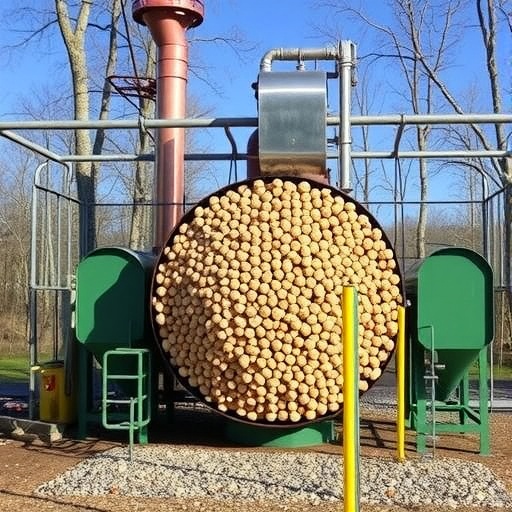Recent advancements in the field of biomass energy have presented a formidable opportunity to utilize organic waste materials as a sustainable energy source. A prominent study, conducted by Karagoz, Haykiri-Acma, and Yaman, elaborates on the steam-only gasification of hazelnut shells, a byproduct that is typically underused. Given the growing concerns over waste management and the quest for renewable energy sources, their research delves deeply into the potential of these organic residues through efficient gasification processes.
Gasification is a thermal treatment process that converts organic or fossil-based materials into carbon monoxide, hydrogen, and carbon dioxide. Utilizing steam as the primary gasifying agent can enhance the efficiency of this transformation, ensuring a higher yield of combustible gases. This study focuses on hazelnut shells, a residue generated in significant quantities by industries related to nut processing. By transforming these shells into valuable energy sources, we can not only minimize waste but also contribute to a circular economy.
In their research, the authors developed a systematic approach to assessing the gasification process of hazelnut shells using the ASPEN Plus simulation software. This advanced computational tool allows for detailed modeling of chemical processes, providing insights into thermodynamic properties, reaction kinetics, and system efficiencies. By simulating various operational conditions, the researchers aimed to optimize the parameters, ensuring maximum gas yield while minimizing energy input.
One of the critical aspects of the study is the analysis of exergy, which measures the maximum useful work that can be extracted from a system as it reaches equilibrium with its environment. By performing an exergy analysis, the authors can determine the efficiency of their gasification system and identify potential areas for improvement. This analysis is particularly relevant for renewable energy systems, as it offers a more comprehensive understanding of the energy transformations taking place.
In conducting their experiments, the researchers noted that the moisture content of the hazelnut shells significantly affected the gasification process. Shells with higher moisture content led to a decrease in gas yield; thus, optimal drying techniques were suggested prior to gasification. Additionally, the temperature and pressure conditions of the gasifier played crucial roles in enhancing the conversion efficiency, with higher temperatures generally favoring the production of syngas.
The study also highlighted the importance of the reaction kinetics involved in the gasification process. It emphasized that the breakdown of biomass into syngas occurs through several complex reactions, including drying, pyrolysis, oxidation, and reduction. By analyzing these reactions, the authors could determine the best parameters to maximize the overall gasification efficiency. This rigorous approach ensures that the findings are not only scientifically robust but also practically applicable.
Another focal point of this research was the environmental implications of using hazelnut shells for energy production. As a renewable energy source, converting organic waste into usable energy could significantly reduce our dependence on fossil fuels. Moreover, it could lead to lower greenhouse gas emissions compared to traditional waste disposal methods, thus contributing to overall environmental sustainability.
Furthermore, the study positioned itself amidst broader trends in biomass energy research. While much attention has been given to conventional feedstocks such as wood, integrating lesser-used materials like hazelnut shells presents novel opportunities. By diversifying the range of biomass sources explored, the research can stimulate further interest and investment in renewable energy technologies.
The implications of the study extend beyond just technical advancements; they bear socio-economic relevance as well. Industries dealing with hazelnut processing could find a dual benefit: enhanced waste management strategies alongside a supplemental energy source. This synergistic approach can promote competitiveness within the sector while aligning with global sustainability goals.
On a practical level, the transition from conventional waste disposal to gasification requires supportive policies and investment in technology. There is a need for collaboration between researchers, industry stakeholders, and policymakers to ensure that the benefits of such innovations can be realized at scale. As technological advances continue to emerge, embracing these changes will be essential in the quest for a sustainable future.
In conclusion, this compelling study by Karagoz, Haykiri-Acma, and Yaman represents a significant step forward in the exploration of sustainable energy sources. The steam-only gasification of hazelnut shells not only showcases the potential of biomass but also underscores the importance of rigorous analytical approaches like exergy assessments. As we face the challenges associated with waste management and energy production, insights from this research could pave the way for practical solutions that benefit both the environment and the economy.
This exploration of biomass gasification points toward a future where waste is not merely discarded, but transformed into valuable resources. Such innovations can play a crucial role in shaping a more sustainable energy landscape, making it imperative for the scientific community to continue exploring novel solutions to our energy challenges.
Subject of Research: Steam-only gasification of hazelnut shells
Article Title: Steam-only Gasification of Hazelnut Shells and Exergy Analysis by ASPEN Plus
Article References:
Karagoz, E., Haykiri-Acma, H. & Yaman, S. Steam-only Gasification of Hazelnut Shells and Exergy Analysis by ASPEN Plus. Waste Biomass Valor (2025). https://doi.org/10.1007/s12649-025-03292-2
Image Credits: AI Generated
DOI: 10.1007/s12649-025-03292-2
Keywords: biomass energy, gasification, hazelnut shells, exergy analysis, ASPEN Plus, renewable energy, sustainability, waste management




